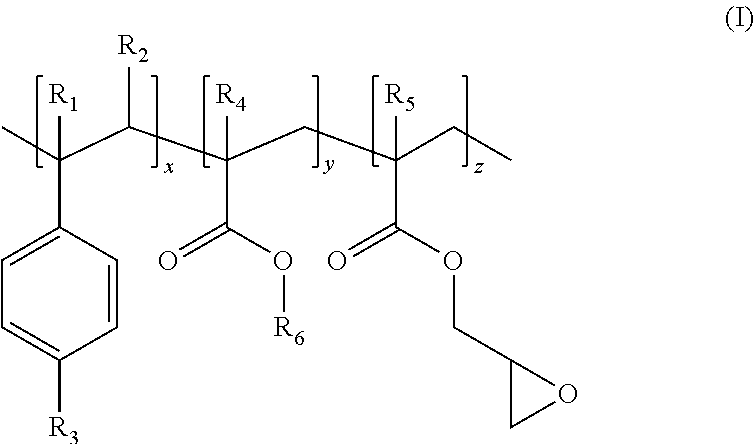Biodegradable Polymer Composition
a polymer composition and biodegradable technology, applied in the direction of medical preparations, pharmaceutical non-active ingredients, etc., can solve the problems of difficult recycling of polymers, relatively few sites remaining available for landfill, and significant problem of consumer waste disposal, so as to reduce the formation of multi-phase morphology, facilitate transesterification, and excellent compatibility between its constituent components
- Summary
- Abstract
- Description
- Claims
- Application Information
AI Technical Summary
Benefits of technology
Problems solved by technology
Method used
Image
Examples
example 1
Preparation of Masterbatch
[0111]35 kg of acetic ester starch (DS of 0.5) having a water content of less than 1 wt. %, 8.5 kg poly(butylene adipate / terephthalate (PBAT), 14 kg of glycerol, 6 kg of sorbitol, 1.2 kg of distilled monoglyceride (GMS), 6 kg of ethylene acrylic acid (EAA) (9% acid, melt flow index=20), 3 kg ethylene vinyl acetate (EVA), 0.2 kg sodium stearate and 0.12 kg sodium hydroxide dissolved in a minimum amount of water were melt mixed in a ZSK-65 Twin Screw Extruder (L / D=48). Prior to melt mixing these components, the solid materials were dry blended first in a high speed mixer and the liquid materials then added to provide for a uniform distribution of all components. The temperature profile of the extruder was set at 100° C. / 130° C. / 160° C. / 160° C. / 150° C. / 140° C. The rotation speed of the screw was set at 300 rpm. A vacuum of −0.06 to −0.08 bar was applied during extrusion. The polymer melt was extruded as a strand, air cooled and cut into pellets. The masterbatc...
example 2
Preparation of a Biodegradable Polymer Composition
[0112]A composition consisting of 30 wt. % of the masterbatch prepared in Example 1, 52.7 wt. % PBAT, 7 wt. % polycaprolactone (PCL), 3 wt % polylactic acid (PLA), 2 wt % GMS, 0.3 wt. % polyepoxide (Joncryl® ADR-4368) and 5 wt % talc was first dry blended and then melt mixed using a ZSK-65 Twin Screw Extruder with a rotational speed of 200 rpm. The temperature profile of the extruder was set at 80° C. / 130° C. / 170° C. / 170° C. / 160° C. / 130° C. A vacuum of −0.04 to −0.05 bar was applied during extrusion. The resulting extrudate was water cooled and cut into pellets and was found to have a melt flow index of 7 g / 10 min, at 190° C. with 2.16 kg.
[0113]The polymer composition prepared in accordance with Example 2 was blown into 20 micron thick film on a standard LDPE blown film line using the processing condition tabulated below.
Processing Conditions—Film Blowing
[0114]
Extruder Speed 40 rpmLine Speed 50 m / minBubble Height4.5 mBlow-up Ratio 3:...
PUM
| Property | Measurement | Unit |
|---|---|---|
| Temperature | aaaaa | aaaaa |
| Temperature | aaaaa | aaaaa |
| Temperature | aaaaa | aaaaa |
Abstract
Description
Claims
Application Information
 Login to View More
Login to View More - R&D
- Intellectual Property
- Life Sciences
- Materials
- Tech Scout
- Unparalleled Data Quality
- Higher Quality Content
- 60% Fewer Hallucinations
Browse by: Latest US Patents, China's latest patents, Technical Efficacy Thesaurus, Application Domain, Technology Topic, Popular Technical Reports.
© 2025 PatSnap. All rights reserved.Legal|Privacy policy|Modern Slavery Act Transparency Statement|Sitemap|About US| Contact US: help@patsnap.com

